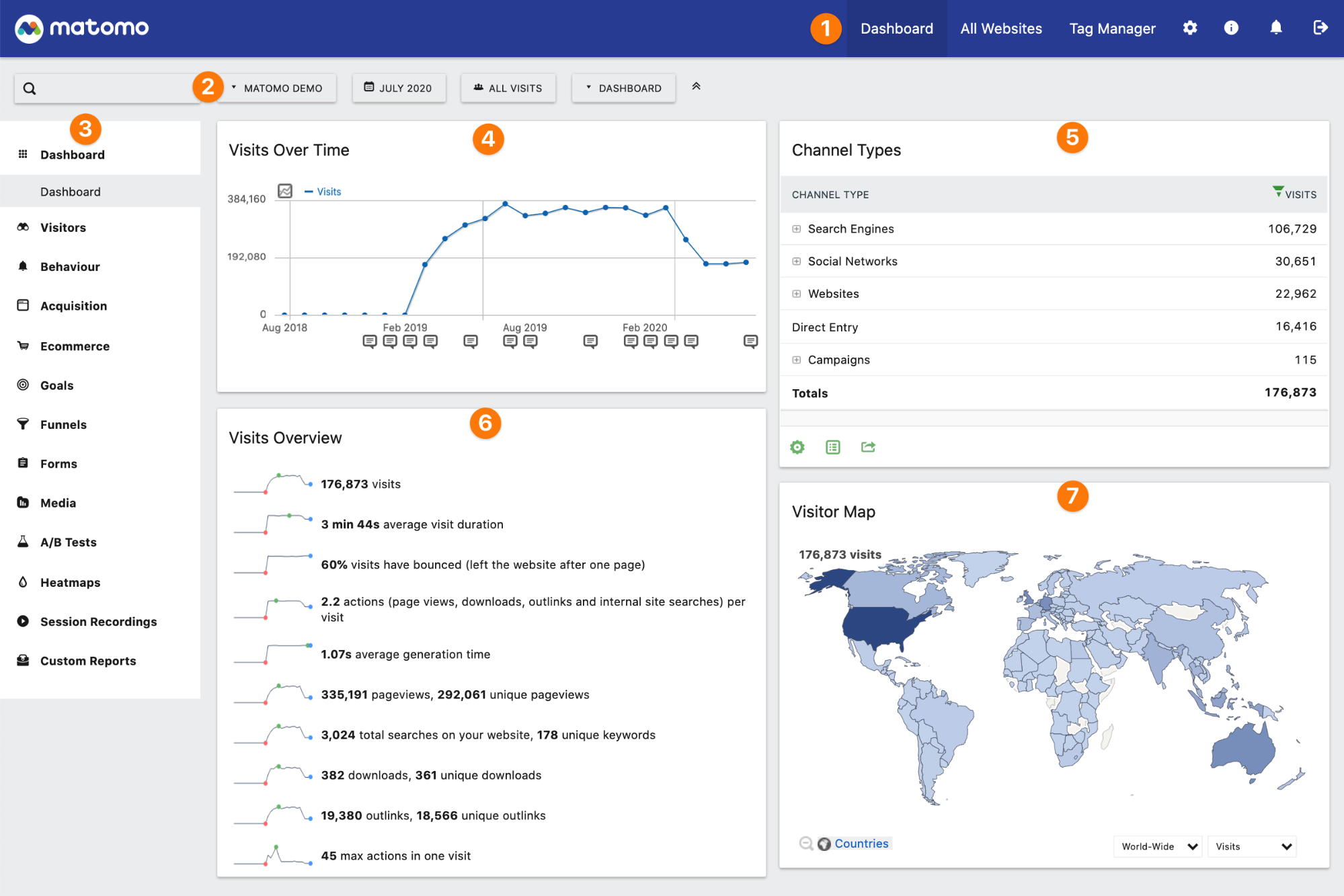Running a small business without analytics is like driving blindfolded through a busy intersection. You might make it through, but why take the risk when powerful, free analytics tools can illuminate your path to success? In today’s data-driven marketplace, understanding your customers’ behavior, website performance, and marketing effectiveness isn’t just helpful—it’s essential for survival and growth.
Whether you’re a startup bootstrapping your way to profitability or an established small business looking to optimize your digital presence, the right analytics tools can provide invaluable insights that drive real business results. Over 60% of marketers use multiple analytics tools to gain insight into their marketing, and for good reason. The beauty of today’s analytics landscape is that you don’t need a massive budget to access professional-grade insights that were once reserved for enterprise companies with deep pockets.

This comprehensive guide will walk you through the top free analytics tools available in 2025, helping you make informed decisions about which solutions best fit your business needs. From comprehensive website tracking to specialized user behavior analysis, we’ll explore how these tools can transform raw data into actionable insights that boost your bottom line.
Why Free Analytics Tools Are Game-Changers for Small Businesses
Small businesses face unique challenges when it comes to data analysis. Limited budgets, small teams, and competing priorities often push analytics to the back burner. However, this approach can be costly in the long run. As a small-to-midsized business (SMB), one of the most powerful things you have in your arsenal is data.
Free analytics tools level the playing field by providing access to sophisticated tracking and analysis capabilities without the financial burden. These tools can help you understand which marketing campaigns generate the best return on investment, identify pages on your website that need improvement, and discover patterns in customer behavior that can inform strategic decisions.
The key is choosing the right combination of tools that complement each other and provide a complete picture of your business performance. Unlike paid solutions that might lock you into long-term contracts, free tools allow you to experiment, learn, and scale your analytics approach as your business grows.
Google Analytics: The Foundation Every Business Needs

When discussing free analytics tools, Google Analytics stands as the undisputed champion. Google Analytics is a comprehensive, all-in-one tool that tracks website metrics, blog visits, social media post performance, and generates customized reports. For most small businesses, Google Analytics serves as the cornerstone of their analytics strategy.
Key Features That Set Google Analytics Apart
Google Analytics 4 (GA4) represents the latest evolution of this powerful platform. Google Analytics 4 (GA4) uses machine learning to analyze user behaviour and automatically uncover trends you might miss, like what pages are most popular or if there are any difficulties during the checkout process. This automated insight generation is particularly valuable for small business owners who may not have dedicated analytics expertise.
The platform excels in several key areas. Explorations: Google Analytics allows you to explore your data through visualization to better understand your audience. From funnel exploration to path exploration, you can take the steps to better understand how your audience interacts with your business through these features.
Data management capabilities make Google Analytics particularly attractive for growing businesses. Data collection and management: Managing your data is a breeze with Google Analytics. Google Analytics enables you to import your own data, all while tying in data from your website.
Getting Started with Google Analytics
Setting up Google Analytics doesn’t require extensive technical knowledge. Setting up GA4 involves adding a tracking code to your website, which can often be done with a plugin for your website builder. This accessibility makes it an ideal starting point for businesses new to analytics.
The integration capabilities with other Google services provide additional value. Integration with other Google tools like Google Ads allows for seamless campaign tracking and optimization, making it easier to measure the effectiveness of your marketing efforts across multiple channels.
Mixpanel: Advanced User Behavior Analytics for Free

While Google Analytics excels at website traffic analysis, Mixpanel takes a different approach by focusing on user behavior and product analytics. One of the best free analytics tools is Mixpanel. The free plan of this tool offers numerous great features that help you analyze your website’s data to better understand how your campaigns perform.
Understanding Mixpanel’s Unique Value Proposition
Mixpanel stands out in the analytics landscape because of its event-based tracking approach. Mixpanel is a specialized product analytics tool for tracking in-app behaviors, segmenting users, and monitoring metrics like retention, engagement, lifetime value, and churn. This focus makes it particularly valuable for businesses with digital products or apps.
The platform’s segmentation capabilities are particularly powerful. User segmentation: Mixpanel’s segmentation tools allow you to group users based on attributes like demographics, behaviors, or interactions within your product. For example, you can segment users by the frequency of product usage or their last interaction with a specific feature.
Free Plan Features and Limitations
Mixpanel’s free offering is surprisingly robust. This free plan offers valuable features and resources — unlimited integrations, unlimited collaborators, templates, and essentials to get started quickly. Early-stage companies that were founded less than 5 years ago, with up to $8M in total funding, and haven’t redeemed any other offers can receive their first year free on the Startup Plan.
The free starter plan allows up to 20M monthly events, which is generous for most small businesses starting their analytics journey. This event-based pricing model means you only pay for the data you actually use, making it cost-effective as you scale.
Microsoft Clarity: Unparalleled Visual Insights at No Cost

Microsoft Clarity represents a newer entrant in the free analytics space, but it’s quickly gaining traction due to its unique visual analytics capabilities. There are a lot of reasons to try out Clarity when finding new ways to improve your website.
Session Recordings and Heatmaps
One of Clarity’s most valuable features is session recording. Session recordings: Session recordings involve filming a volunteer user as they accomplish set tasks given to them, like finding a specific page. These are used to determine how user-friendly your website is and lets you improve your UX. This feature provides insights that traditional analytics tools simply cannot match.
The real-time capabilities of Clarity set it apart from many competitors. Real-time insights: Clarity analyzes data and generates insights at almost real-time speeds. Machine learning and DeepAI are used to create invaluable insights and information while it analyzes user behavior.
Unlimited Features for Growing Businesses
Unlike many analytics tools that impose strict limitations on their free plans, Clarity takes a different approach. Unlimited offerings: With Clarity, you get a lot of unlimited features — unlimited traffic, heatmaps, websites, and team members. It’s built for businesses of all needs and scales. This unlimited approach makes it particularly attractive for businesses expecting rapid growth.
Matomo: Privacy-First Analytics with Complete Data Ownership

In an era of increasing privacy concerns, Matomo offers a compelling alternative to traditional analytics platforms. One of the best free website analytics tools is Matomo. Matamo is a high-powered website analytics platform that gives you ownership over your data.
Privacy and Data Ownership Benefits
Matomo’s approach to privacy sets it apart in the analytics landscape. With 100% data ownership, users can safely use analytics without worrying about data being used for marketing or any other purposes. This level of control is particularly important for businesses operating in regulated industries or those serving privacy-conscious customers.
The platform’s compliance capabilities are comprehensive. Protect your and your users’ privacy with a tool compliant with the strictest of privacy laws, including GDPR, HIPAA, CCPA, LGPD, and PECR. This compliance coverage can save small businesses significant time and resources that would otherwise be spent on privacy compliance consulting.
Comprehensive Analytics Features
Despite its privacy focus, Matomo doesn’t compromise on functionality. Matomo on-premise includes all the core website analytics features, such as user and event tracking, e-commerce tracking, customizable dashboards, user segmentation, scheduled email reports, and alerts. These features rival those found in premium analytics platforms.
Open Web Analytics: Complete Control for Technical Users

For businesses with technical expertise, Open Web Analytics (OWA) offers an open-source alternative that provides complete control over the analytics implementation. Open Web Analytics (OWA) is a free and open-source web analytics tool that gives you ways to track, monitor, and analyze the way people use your websites and applications.
Technical Advantages and Control
The open-source nature of OWA provides several unique advantages. First-party control: You can run OWA as a part of your website under your domain. This level of control ensures that your analytics data never leaves your infrastructure, providing the highest level of data security and privacy.
Integration capabilities make OWA particularly attractive for businesses using specific content management systems. CRM systems: OWA provides website analytics with WordPress and MediaWiki support and integration.
Privacy and Compliance Features
Like Matomo, OWA prioritizes privacy and compliance. Privacy: OWA is compliant with GDRP and many other Internet privacy frameworks, meaning your data and information will be protected and secure. The ability to maintain complete control over data storage and processing makes it easier to ensure compliance with various regulatory requirements.
Specialized Analytics Tools for Specific Needs
Beyond the major platforms, several specialized free analytics tools can provide valuable insights for specific use cases. These tools often complement your primary analytics platform by offering deeper insights into particular aspects of your business performance.
Simple Analytics: Minimalist Privacy-Focused Tracking

For businesses that prefer simplicity over complexity, Simple Analytics offers a streamlined approach. We do not use cookies and never collect information that could be used to fingerprint a user. You do not need to tweak any settings to make our software privacy-friendly: Simple Analytics is privacy-friendly by design.
Umami: Open Source Simplicity

Among the open-source options, Umami stands out for its balance of features and simplicity. Umami tracks all common website metrics, supports custom events, and offers basic funnel, user path, and retention analysis as well. You can track up to 100k events per month on Umami Cloud for free, making it suitable for many small businesses.
Choosing the Right Combination of Tools
The most effective analytics strategy often involves using multiple tools that complement each other. Due to their differences, Mixpanel and GA are often used as complementary tools, with the former focusing on product analytics and the latter on website analytics.
Consider your business model, technical expertise, and specific analytics needs when selecting tools. A content-focused website might benefit most from Google Analytics and Clarity, while a SaaS application might find more value in combining Google Analytics with Mixpanel for comprehensive user behavior tracking.
Integration and Data Flow Considerations
When using multiple analytics tools, consider how data flows between them. Many tools offer integration capabilities that can help create a more complete picture of your business performance. Userpilot has built-in integrations with tools like Amplitude, Mixpanel, Kissmetrics, Segment, Heap, HubSpot, Intercom, Google Analytics, and Google Tag Manager so you can share data between all the solutions in your tech stack.
Implementation Best Practices for Maximum Impact
Successful analytics implementation goes beyond simply installing tracking codes. Start with clear goals and key performance indicators (KPIs) that align with your business objectives. Define what success looks like for your specific situation, whether that’s increased website conversions, improved user engagement, or better understanding of customer behavior patterns.
Ensure proper setup and configuration of your chosen tools. Many businesses miss valuable insights because of incomplete or incorrect implementation. Take time to properly configure goal tracking, event tracking, and user segmentation to maximize the value of your analytics data.
Regular review and optimization of your analytics setup ensures continued relevance and accuracy. As your business evolves, your analytics needs will change. Regularly assess whether your current tools and configuration still meet your requirements.

Conclusion: Transforming Data Into Business Growth
Free analytics tools have democratized access to powerful business insights that were once available only to large enterprises. From Google Analytics’ comprehensive website tracking to Mixpanel’s advanced user behavior analysis, these tools provide the foundation for data-driven decision making without straining your budget.
The key to success lies not in using every available tool, but in selecting the right combination that addresses your specific business needs. Start with one or two core tools, master their capabilities, and then gradually expand your analytics ecosystem as your needs grow and your expertise develops.
Remember that analytics tools are only as valuable as the actions you take based on their insights. The most sophisticated analytics setup in the world won’t improve your business unless you regularly review the data, identify opportunities for improvement, and implement changes based on what you learn.
As you embark on your analytics journey, focus on consistency and gradual improvement rather than trying to track everything at once. The businesses that succeed with analytics are those that build sustainable, long-term practices around data collection, analysis, and action.
Frequently Asked Questions
Q: Which free analytics tool should I start with as a complete beginner? A: Google Analytics is the best starting point for most businesses. It’s free, well-documented, and provides comprehensive website analytics that serve as the foundation for understanding your online presence. Once you’re comfortable with Google Analytics, you can add specialized tools like Mixpanel or Clarity based on your specific needs.
Q: Can I use multiple free analytics tools simultaneously? A: Absolutely! Many successful businesses use multiple analytics tools that complement each other. For example, you might use Google Analytics for overall website performance, Mixpanel for user behavior analysis, and Clarity for visual insights. Just ensure you have the technical capacity to manage multiple tools effectively.
Q: Are free analytics tools really sufficient for small businesses, or do I need paid solutions? A: Free analytics tools can absolutely meet the needs of most small businesses. Tools like Google Analytics, Mixpanel’s free plan, and Microsoft Clarity offer enterprise-grade features at no cost. You’ll likely only need paid solutions as you scale significantly or require specialized features like advanced attribution modeling or extensive historical data storage.
Q: How do I ensure privacy compliance when using free analytics tools? A: Choose privacy-focused tools like Matomo, Simple Analytics, or Open Web Analytics if privacy is a primary concern. These tools are designed with privacy compliance in mind and often don’t require cookie banners. For other tools, ensure you properly configure privacy settings and include appropriate disclosures in your privacy policy.
Q: What’s the difference between website analytics and product analytics? A: Website analytics (like Google Analytics) focus on how visitors interact with your website – page views, traffic sources, and basic user behavior. Product analytics (like Mixpanel) dive deeper into how users interact with your actual product or application – feature usage, user journeys, and engagement patterns. Most businesses benefit from both types of insights.
Q: How long does it take to see meaningful results from analytics tools? A: You can start seeing basic insights immediately after implementation, but meaningful patterns typically emerge after 2-4 weeks of data collection. The key is consistent tracking and regular review of your data. Set aside time weekly to review your analytics and look for trends or opportunities for improvement.
Ready to transform your business with data-driven insights? The analytics tools we’ve discussed are all available for free and can be implemented today. Start with Google Analytics as your foundation, then explore specialized tools based on your specific needs.
Share your analytics success stories in the comments below! Which free analytics tools have made the biggest impact on your business? Your experience could help other small business owners discover new opportunities for growth.
Don’t forget to bookmark this guide and share it with fellow entrepreneurs who could benefit from these powerful free analytics tools. The path to data-driven success starts with taking the first step – and that step doesn’t have to cost you anything.




Leave a Reply